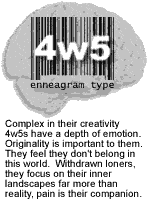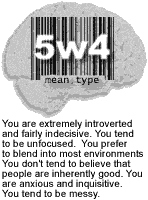Another web personality test, this time Enneagram. I have no clue what most of the yammering and psychobabble means, but this part is plenty clear:
|
Conscious self
|
Overall self
|
 |
 |
It seems that I’m just a horrible, horrible person. Well, big deal — I already knew that.
The test results were presented as a bunch of obstruse charts, giving me no real clue whether this is or isn’t a valid method of analysis. But then again, asking someone 126 carefully crafted questions is pretty much guaranteed to give you a blanket description of their personality. Still, these mean nothing at all to me:



Type 4w5. Your mean type, Type 5w4, is who you are, on average, based on the sum influence of all nine type behaviors. Your mean type is a better predictor of how you generally act whereas your main type reflects how you prefer to act. By analogy, if you were a bus with nine different possible drivers, your main type is the most frequently used driver (which suggests you prefer that behavior/driver) but your mean type represents the sum influence of all nine drivers. Another way to look at it is that your mean type reflects where you are overall in the evolutionary race and your main type reflects the direction you are most often choosing to move in (if it’s higher than your mean type you are moving forward, otherwise you are moving backward or nowhere). Most Enneagram books and tests focus on main type and use an additional “variant” classification to account for the influence of the other eight behavior types (drivers). Based on your test results your variant is Sexual. So when reading other Enneagram books or websites refer to the Type 4w5, Sexual variant descriptions.
Everyone utilizes all nine behaviors to some degree, but some overly favor less useful behaviors. The upper behaviors (4,5,6) reflect moving forward (5 behavior is the most progress conducive), the middle behaviors (3 and 7) reflect minimal progress or staying the same, and the lower behaviors reflect going backwards (clinging to the past). People stuck more often on statis quo (3 and 7) and backward behaviors (2, 1, 9, 8) will develop less in life, then again to be too progressive all the time (4,5,6) can burn you out physically (so if you have a really high Vmean be attentive to physical burn out). You can’t usually master higher behaviors without first resolving excessive attachments or deficiencies to lower type behaviors. If you have absolutely no sense of organization (type 1), you are unlikely to succeed at anything. On the other hand if you are obsessed with organization, you won’t accomplish much either.
My comprehension of this is non-existent, so I tend to focus on the fact that my variant is sexual. I find this both amusing and comforting. I don’t know why.
I too am a 4 with a 5 wing, as my main type (though my mean type, according to this test, was 4w3; mean type is something I’ve not encountered before in my 6+ year exploration of the enneagram).
The enneagram is most useful, I think, as a purely personal tool for understanding patterns of thinking and behaving. Each of the nine types–which are all equally “valid”–are divided into nine steps, three optimal, “healthy” ways of being, within the type; three average; and three sub-optimal and “unhealthy.” Each of us moves up and down within these nine steps all the time, though we tend to have a resting point somewhere within the continuum. Each type also has one other type the behaviors of which it tends to move toward in times of stress, and another type in times of peace and assurance.
It’s a tool that some consider pseudo-science, and I think there’s potential danger–just as with the Myers-Briggs, which it resembles in some aspects–in trying to use it as a way to stereotype oneself or others or to excuse behaviors in oneself. But I find it very valuable as a diagnostic tool for personal development. It doesn’t provide cures or solutions, but it can offer some insights into underlying behaviors and fixations and even potentially provide landmarks for when I’m moving forward or backwards emotionally.